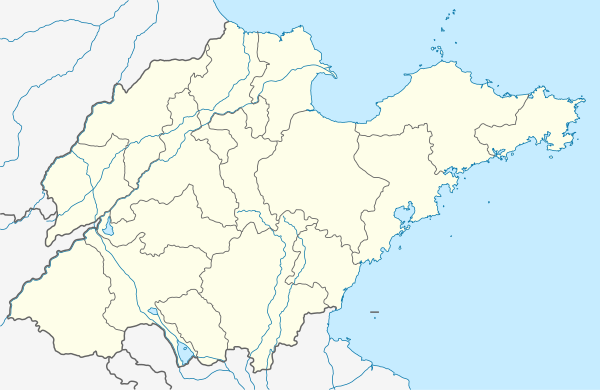Zhoucun District
Zhoucun district (Chinese: 周村区; pinyin: Zhōucūn Qū) is a town and district of agricultural land inside Zibo city. The city covers 307 km2 (119 sq mi) and had an estimated population of 288,440 in 2013.[1] Its main industry is textiles and furniture manufacture. The center of the commercial district has a recently refurbished area with traditional buildings. Some of the filming for Zhang Yimou's film To Live was done in the district.[2]
Zhoucun District
周村区 | |
|---|---|
 Location in Zibo | |
 Zhoucun Location in Shandong | |
| Coordinates: 36°48′14″N 117°52′05″E | |
| Country | People's Republic of China |
| Province | Shandong |
| Prefecture-level city | Zibo |
| Area | |
| • Total | 307 km2 (119 sq mi) |
| Population (2018) | |
| • Total | 287,494 |
| • Density | 940/km2 (2,400/sq mi) |
| Time zone | UTC+8 (China Standard) |
| Postal code | 255300 |
| Area code(s) | +86 0533 |
Historical anecdote
In the 17th century, the textile industry was flourishing in Zhoucun, while the local government was corrupted to a point that it set up a department called "二公衙门" for extorting money. The department hired parasitic scumbags to levy various high taxes. It was not long before the merchants disappointed and began to leave.
Meanwhile, the Ministry of Justice of the Qing Government, Huahsi Lee, came back to Zhoucun to see his family. He was outraged by the state of the economy of his hometown, and reported to Emperor Shunzhi. It would have been embarrassing for Shunzhi not to show his mercy, but inadequate to take ease on his taxes. He compromised: Zhoucun shall take only one day off the tax.
This kind of stingy "mercy" was really some gigantic excrement drained upon Huahsi's head, but he thought of a way around it. Hushsi made orders to build a monument with "今日无税" ("No Tax Today") carvings ambiguously under the command of the emperor, so merchants are able to do business tax-free all the time.
Later on Huahsi felt guilty about tax evasion and undertook the taxes himself. Huahsi even promised that whoever got robbed within 200 Li(about 115 km) around Zhoucun shall get reparation from his family. Such act maintained for seven generations, about 200 years.
The economically preposterous and doubtful monument is still at the center of the relics called "周村大街", but it was long invalid.[3]
Administrative divisions
As 2012, this County is divided to 5 subdistricts and 4 towns.[4]
- Subdistricts
|
|
- Towns
|
|
References
- "淄博市周村区2013年国民经济和社会发展统计公报". 2014-04-01.
- Credits at the movie's end.
- 淄博市周村区2010年国民经济和社会发展统计公报. 2011-03-31.
- 淄博市-行政区划网 www.xzqh.org (in Chinese). XZQH. Retrieved 2012-05-24.